University Dissertation Progress Report: Rolling Machine Lubrication
VerifiedAdded on 2021/06/17
|32
|8268
|155
Report
AI Summary
This dissertation progress report focuses on the critical issue of lubrication in high-temperature rolling machines. The report begins by defining the problem: the extreme wear, tear, and frictional erosion experienced by rolling machines, particularly in the context of solid-state and semi-solid-state metal and non-metal reshaping processes. It highlights the challenges associated with conventional lubricants, including their limited distribution and the resulting inefficiencies, as well as the impact of high temperatures on machine performance and material quality. The research aims to identify the most efficient lubricant components, analyzing oil, water emulsions, and titanium oxide-based emulsions to enhance production quality and machine durability. Objectives include understanding the physical and chemical properties of each lubricant type and determining the best combinations to reduce wear, friction, and improve surface finish. The scope encompasses literature review and real-time data analysis, focusing on vertical and horizontal rolling systems, with a focus on cost-effectiveness and operational efficiency. The report also includes an extensive literature review that explores the causes of friction, the structure of the roller surface, and the limitations of existing lubrication methods. The ultimate goal is to improve the efficiency and longevity of rolling machines through innovative lubrication solutions.
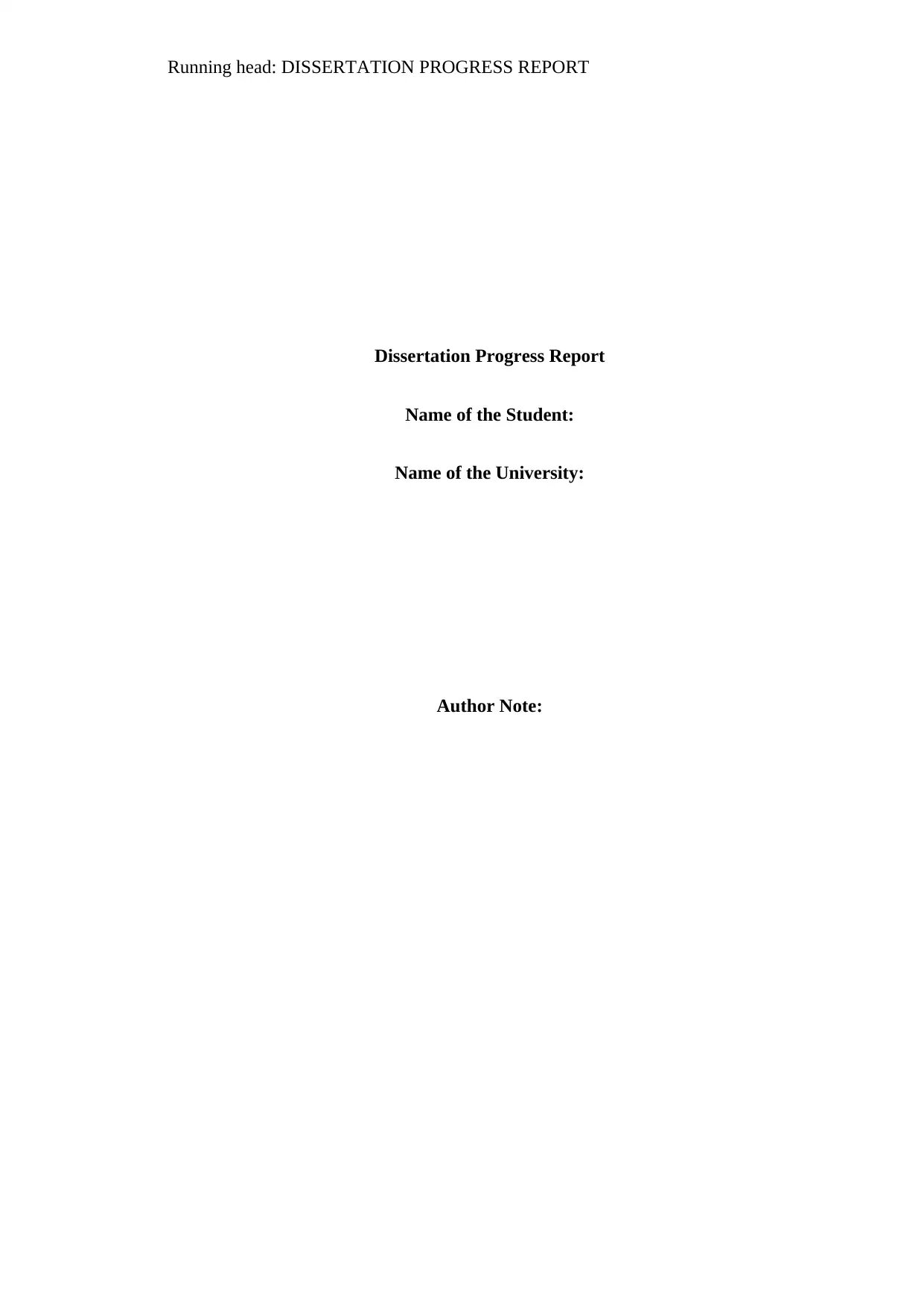
Running head: DISSERTATION PROGRESS REPORT
Dissertation Progress Report
Name of the Student:
Name of the University:
Author Note:
Dissertation Progress Report
Name of the Student:
Name of the University:
Author Note:
Paraphrase This Document
Need a fresh take? Get an instant paraphrase of this document with our AI Paraphraser
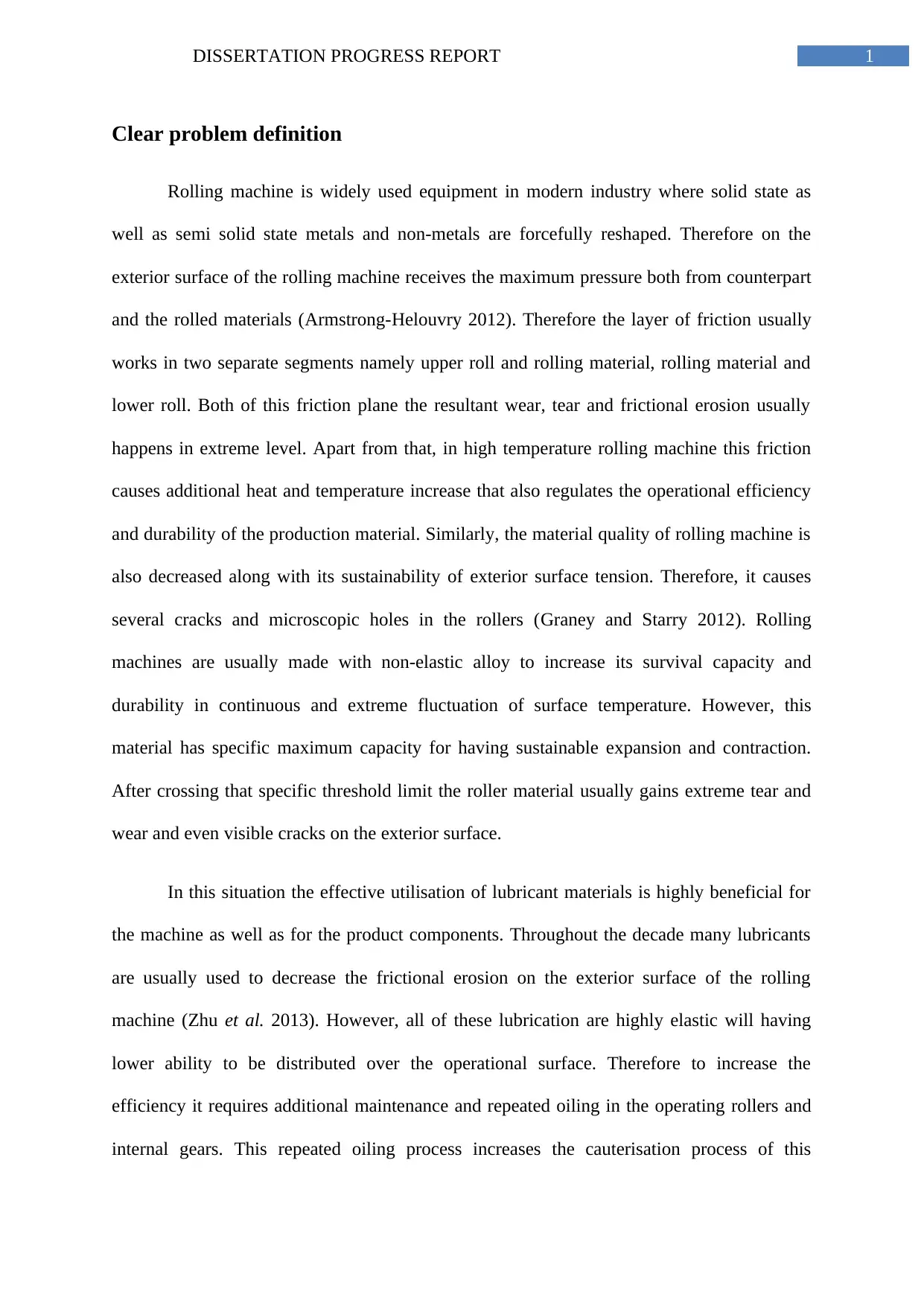
1DISSERTATION PROGRESS REPORT
Clear problem definition
Rolling machine is widely used equipment in modern industry where solid state as
well as semi solid state metals and non-metals are forcefully reshaped. Therefore on the
exterior surface of the rolling machine receives the maximum pressure both from counterpart
and the rolled materials (Armstrong-Helouvry 2012). Therefore the layer of friction usually
works in two separate segments namely upper roll and rolling material, rolling material and
lower roll. Both of this friction plane the resultant wear, tear and frictional erosion usually
happens in extreme level. Apart from that, in high temperature rolling machine this friction
causes additional heat and temperature increase that also regulates the operational efficiency
and durability of the production material. Similarly, the material quality of rolling machine is
also decreased along with its sustainability of exterior surface tension. Therefore, it causes
several cracks and microscopic holes in the rollers (Graney and Starry 2012). Rolling
machines are usually made with non-elastic alloy to increase its survival capacity and
durability in continuous and extreme fluctuation of surface temperature. However, this
material has specific maximum capacity for having sustainable expansion and contraction.
After crossing that specific threshold limit the roller material usually gains extreme tear and
wear and even visible cracks on the exterior surface.
In this situation the effective utilisation of lubricant materials is highly beneficial for
the machine as well as for the product components. Throughout the decade many lubricants
are usually used to decrease the frictional erosion on the exterior surface of the rolling
machine (Zhu et al. 2013). However, all of these lubrication are highly elastic will having
lower ability to be distributed over the operational surface. Therefore to increase the
efficiency it requires additional maintenance and repeated oiling in the operating rollers and
internal gears. This repeated oiling process increases the cauterisation process of this
Clear problem definition
Rolling machine is widely used equipment in modern industry where solid state as
well as semi solid state metals and non-metals are forcefully reshaped. Therefore on the
exterior surface of the rolling machine receives the maximum pressure both from counterpart
and the rolled materials (Armstrong-Helouvry 2012). Therefore the layer of friction usually
works in two separate segments namely upper roll and rolling material, rolling material and
lower roll. Both of this friction plane the resultant wear, tear and frictional erosion usually
happens in extreme level. Apart from that, in high temperature rolling machine this friction
causes additional heat and temperature increase that also regulates the operational efficiency
and durability of the production material. Similarly, the material quality of rolling machine is
also decreased along with its sustainability of exterior surface tension. Therefore, it causes
several cracks and microscopic holes in the rollers (Graney and Starry 2012). Rolling
machines are usually made with non-elastic alloy to increase its survival capacity and
durability in continuous and extreme fluctuation of surface temperature. However, this
material has specific maximum capacity for having sustainable expansion and contraction.
After crossing that specific threshold limit the roller material usually gains extreme tear and
wear and even visible cracks on the exterior surface.
In this situation the effective utilisation of lubricant materials is highly beneficial for
the machine as well as for the product components. Throughout the decade many lubricants
are usually used to decrease the frictional erosion on the exterior surface of the rolling
machine (Zhu et al. 2013). However, all of these lubrication are highly elastic will having
lower ability to be distributed over the operational surface. Therefore to increase the
efficiency it requires additional maintenance and repeated oiling in the operating rollers and
internal gears. This repeated oiling process increases the cauterisation process of this
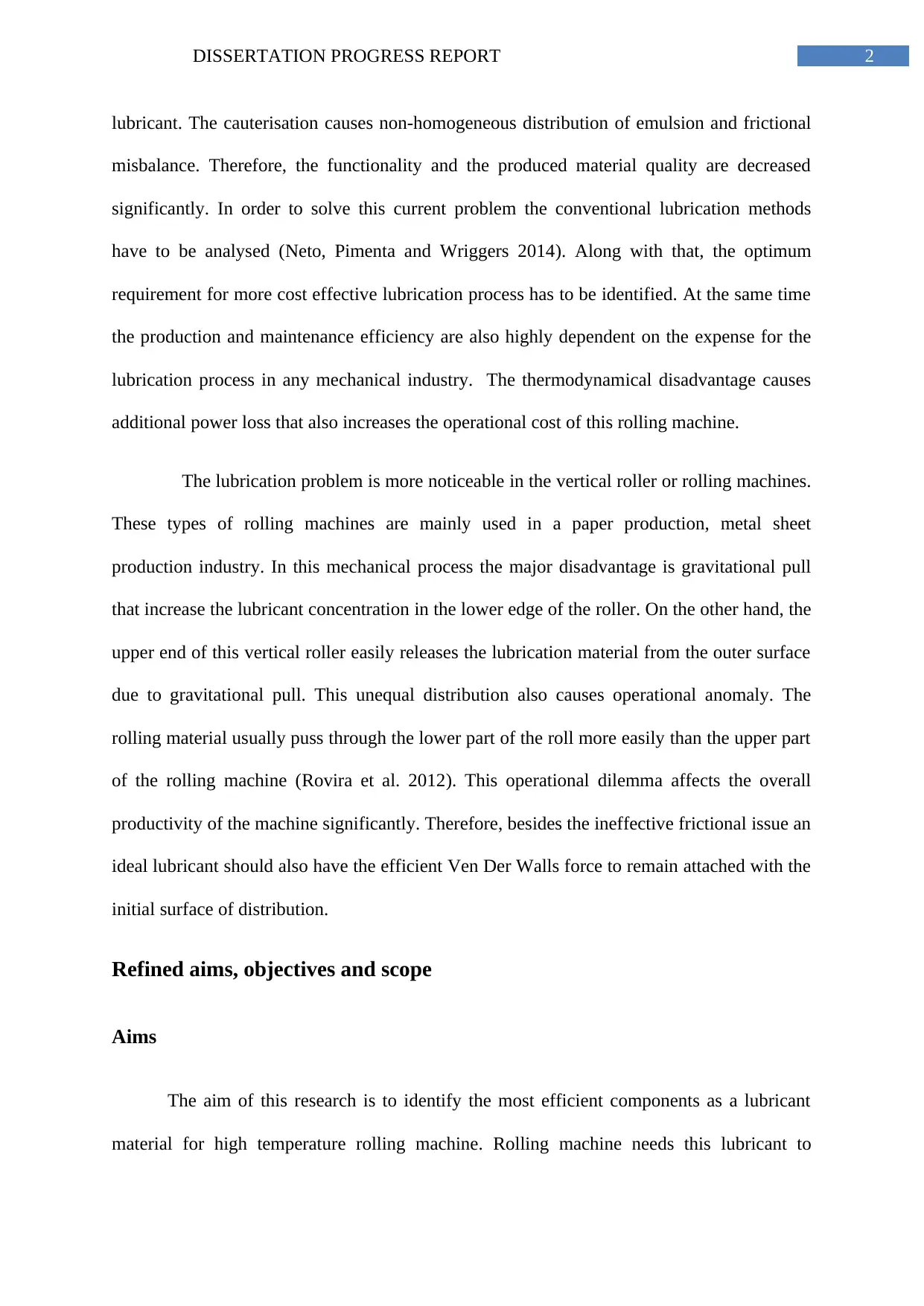
2DISSERTATION PROGRESS REPORT
lubricant. The cauterisation causes non-homogeneous distribution of emulsion and frictional
misbalance. Therefore, the functionality and the produced material quality are decreased
significantly. In order to solve this current problem the conventional lubrication methods
have to be analysed (Neto, Pimenta and Wriggers 2014). Along with that, the optimum
requirement for more cost effective lubrication process has to be identified. At the same time
the production and maintenance efficiency are also highly dependent on the expense for the
lubrication process in any mechanical industry. The thermodynamical disadvantage causes
additional power loss that also increases the operational cost of this rolling machine.
The lubrication problem is more noticeable in the vertical roller or rolling machines.
These types of rolling machines are mainly used in a paper production, metal sheet
production industry. In this mechanical process the major disadvantage is gravitational pull
that increase the lubricant concentration in the lower edge of the roller. On the other hand, the
upper end of this vertical roller easily releases the lubrication material from the outer surface
due to gravitational pull. This unequal distribution also causes operational anomaly. The
rolling material usually puss through the lower part of the roll more easily than the upper part
of the rolling machine (Rovira et al. 2012). This operational dilemma affects the overall
productivity of the machine significantly. Therefore, besides the ineffective frictional issue an
ideal lubricant should also have the efficient Ven Der Walls force to remain attached with the
initial surface of distribution.
Refined aims, objectives and scope
Aims
The aim of this research is to identify the most efficient components as a lubricant
material for high temperature rolling machine. Rolling machine needs this lubricant to
lubricant. The cauterisation causes non-homogeneous distribution of emulsion and frictional
misbalance. Therefore, the functionality and the produced material quality are decreased
significantly. In order to solve this current problem the conventional lubrication methods
have to be analysed (Neto, Pimenta and Wriggers 2014). Along with that, the optimum
requirement for more cost effective lubrication process has to be identified. At the same time
the production and maintenance efficiency are also highly dependent on the expense for the
lubrication process in any mechanical industry. The thermodynamical disadvantage causes
additional power loss that also increases the operational cost of this rolling machine.
The lubrication problem is more noticeable in the vertical roller or rolling machines.
These types of rolling machines are mainly used in a paper production, metal sheet
production industry. In this mechanical process the major disadvantage is gravitational pull
that increase the lubricant concentration in the lower edge of the roller. On the other hand, the
upper end of this vertical roller easily releases the lubrication material from the outer surface
due to gravitational pull. This unequal distribution also causes operational anomaly. The
rolling material usually puss through the lower part of the roll more easily than the upper part
of the rolling machine (Rovira et al. 2012). This operational dilemma affects the overall
productivity of the machine significantly. Therefore, besides the ineffective frictional issue an
ideal lubricant should also have the efficient Ven Der Walls force to remain attached with the
initial surface of distribution.
Refined aims, objectives and scope
Aims
The aim of this research is to identify the most efficient components as a lubricant
material for high temperature rolling machine. Rolling machine needs this lubricant to
⊘ This is a preview!⊘
Do you want full access?
Subscribe today to unlock all pages.

Trusted by 1+ million students worldwide
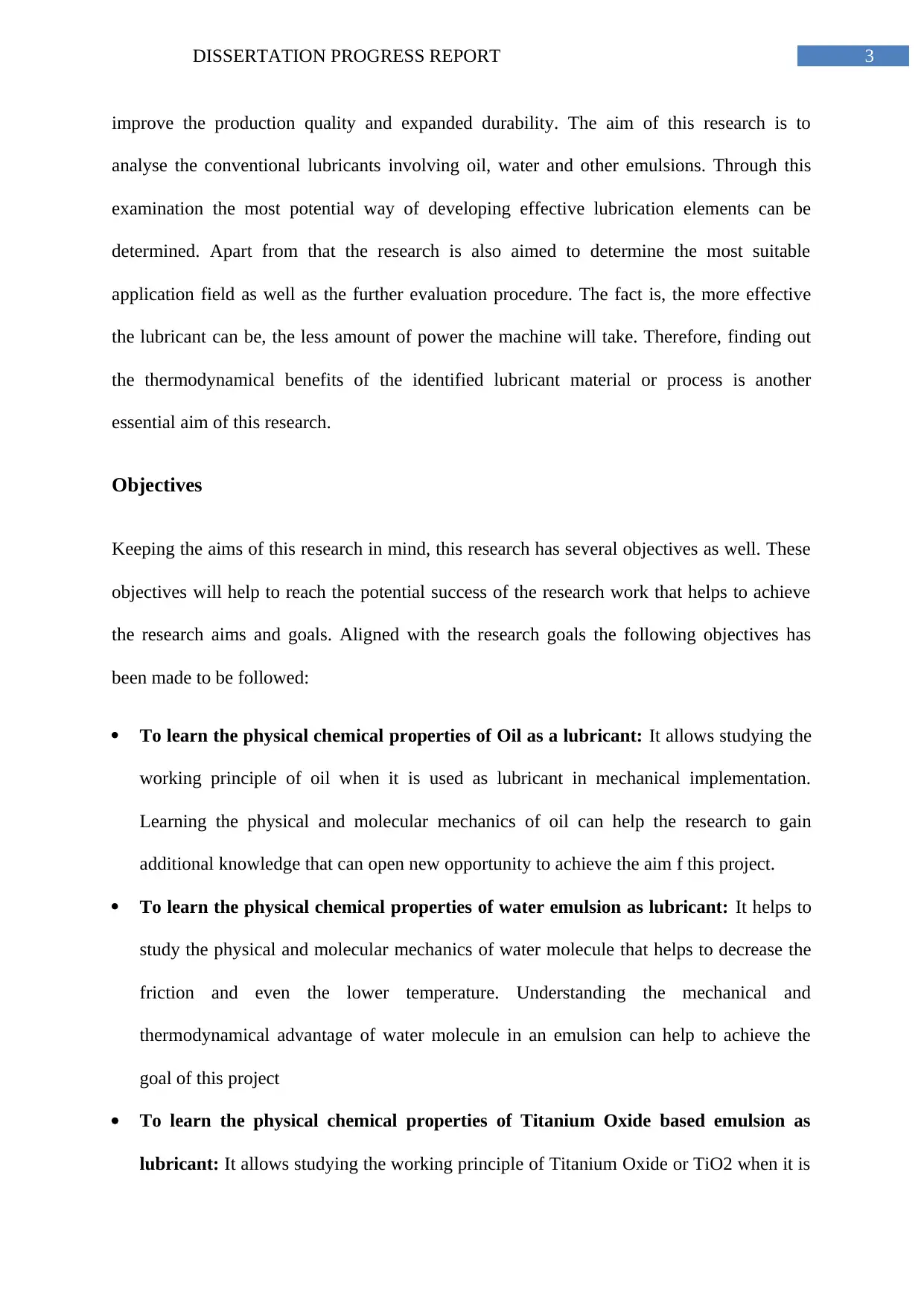
3DISSERTATION PROGRESS REPORT
improve the production quality and expanded durability. The aim of this research is to
analyse the conventional lubricants involving oil, water and other emulsions. Through this
examination the most potential way of developing effective lubrication elements can be
determined. Apart from that the research is also aimed to determine the most suitable
application field as well as the further evaluation procedure. The fact is, the more effective
the lubricant can be, the less amount of power the machine will take. Therefore, finding out
the thermodynamical benefits of the identified lubricant material or process is another
essential aim of this research.
Objectives
Keeping the aims of this research in mind, this research has several objectives as well. These
objectives will help to reach the potential success of the research work that helps to achieve
the research aims and goals. Aligned with the research goals the following objectives has
been made to be followed:
To learn the physical chemical properties of Oil as a lubricant: It allows studying the
working principle of oil when it is used as lubricant in mechanical implementation.
Learning the physical and molecular mechanics of oil can help the research to gain
additional knowledge that can open new opportunity to achieve the aim f this project.
To learn the physical chemical properties of water emulsion as lubricant: It helps to
study the physical and molecular mechanics of water molecule that helps to decrease the
friction and even the lower temperature. Understanding the mechanical and
thermodynamical advantage of water molecule in an emulsion can help to achieve the
goal of this project
To learn the physical chemical properties of Titanium Oxide based emulsion as
lubricant: It allows studying the working principle of Titanium Oxide or TiO2 when it is
improve the production quality and expanded durability. The aim of this research is to
analyse the conventional lubricants involving oil, water and other emulsions. Through this
examination the most potential way of developing effective lubrication elements can be
determined. Apart from that the research is also aimed to determine the most suitable
application field as well as the further evaluation procedure. The fact is, the more effective
the lubricant can be, the less amount of power the machine will take. Therefore, finding out
the thermodynamical benefits of the identified lubricant material or process is another
essential aim of this research.
Objectives
Keeping the aims of this research in mind, this research has several objectives as well. These
objectives will help to reach the potential success of the research work that helps to achieve
the research aims and goals. Aligned with the research goals the following objectives has
been made to be followed:
To learn the physical chemical properties of Oil as a lubricant: It allows studying the
working principle of oil when it is used as lubricant in mechanical implementation.
Learning the physical and molecular mechanics of oil can help the research to gain
additional knowledge that can open new opportunity to achieve the aim f this project.
To learn the physical chemical properties of water emulsion as lubricant: It helps to
study the physical and molecular mechanics of water molecule that helps to decrease the
friction and even the lower temperature. Understanding the mechanical and
thermodynamical advantage of water molecule in an emulsion can help to achieve the
goal of this project
To learn the physical chemical properties of Titanium Oxide based emulsion as
lubricant: It allows studying the working principle of Titanium Oxide or TiO2 when it is
Paraphrase This Document
Need a fresh take? Get an instant paraphrase of this document with our AI Paraphraser
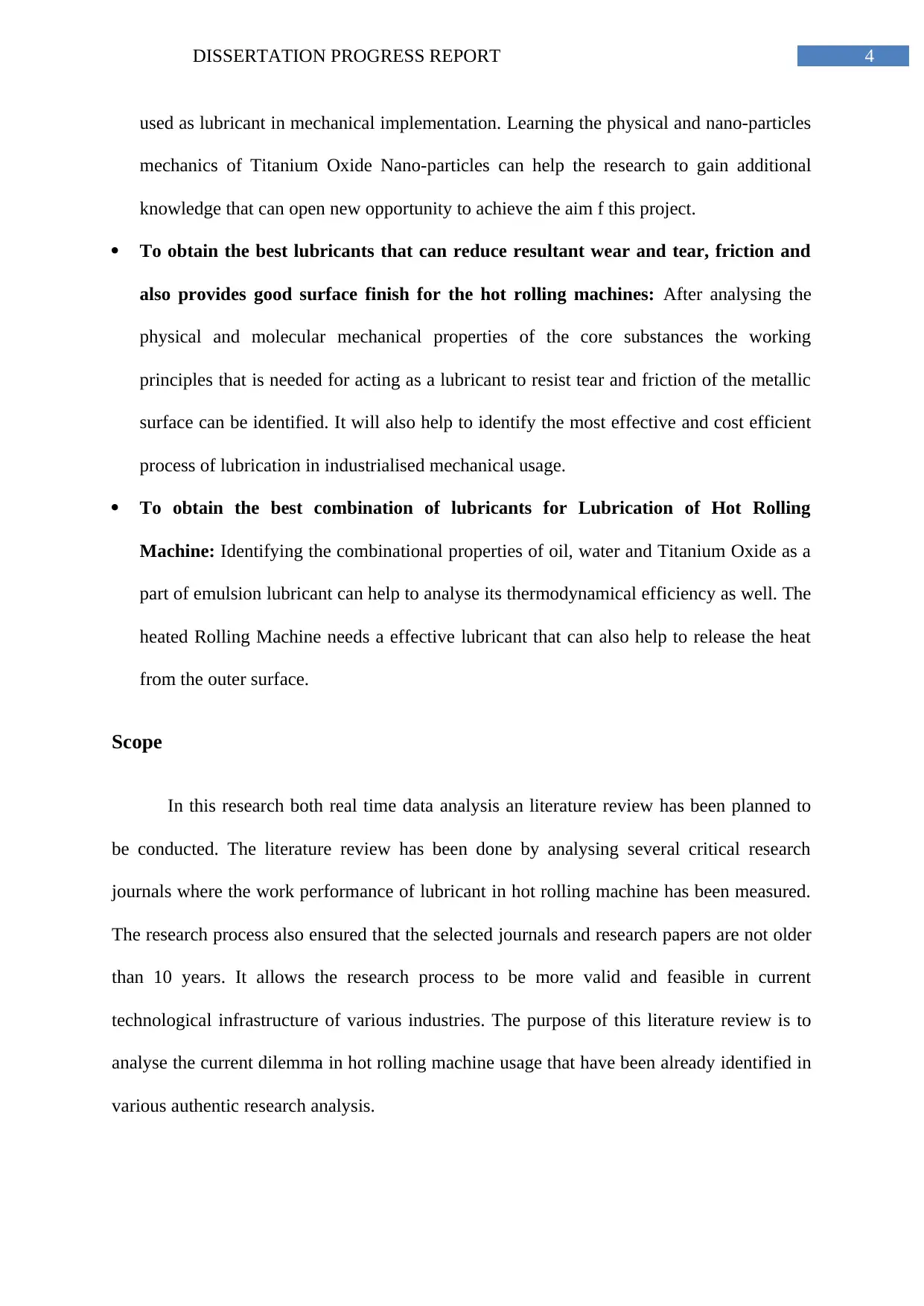
4DISSERTATION PROGRESS REPORT
used as lubricant in mechanical implementation. Learning the physical and nano-particles
mechanics of Titanium Oxide Nano-particles can help the research to gain additional
knowledge that can open new opportunity to achieve the aim f this project.
To obtain the best lubricants that can reduce resultant wear and tear, friction and
also provides good surface finish for the hot rolling machines: After analysing the
physical and molecular mechanical properties of the core substances the working
principles that is needed for acting as a lubricant to resist tear and friction of the metallic
surface can be identified. It will also help to identify the most effective and cost efficient
process of lubrication in industrialised mechanical usage.
To obtain the best combination of lubricants for Lubrication of Hot Rolling
Machine: Identifying the combinational properties of oil, water and Titanium Oxide as a
part of emulsion lubricant can help to analyse its thermodynamical efficiency as well. The
heated Rolling Machine needs a effective lubricant that can also help to release the heat
from the outer surface.
Scope
In this research both real time data analysis an literature review has been planned to
be conducted. The literature review has been done by analysing several critical research
journals where the work performance of lubricant in hot rolling machine has been measured.
The research process also ensured that the selected journals and research papers are not older
than 10 years. It allows the research process to be more valid and feasible in current
technological infrastructure of various industries. The purpose of this literature review is to
analyse the current dilemma in hot rolling machine usage that have been already identified in
various authentic research analysis.
used as lubricant in mechanical implementation. Learning the physical and nano-particles
mechanics of Titanium Oxide Nano-particles can help the research to gain additional
knowledge that can open new opportunity to achieve the aim f this project.
To obtain the best lubricants that can reduce resultant wear and tear, friction and
also provides good surface finish for the hot rolling machines: After analysing the
physical and molecular mechanical properties of the core substances the working
principles that is needed for acting as a lubricant to resist tear and friction of the metallic
surface can be identified. It will also help to identify the most effective and cost efficient
process of lubrication in industrialised mechanical usage.
To obtain the best combination of lubricants for Lubrication of Hot Rolling
Machine: Identifying the combinational properties of oil, water and Titanium Oxide as a
part of emulsion lubricant can help to analyse its thermodynamical efficiency as well. The
heated Rolling Machine needs a effective lubricant that can also help to release the heat
from the outer surface.
Scope
In this research both real time data analysis an literature review has been planned to
be conducted. The literature review has been done by analysing several critical research
journals where the work performance of lubricant in hot rolling machine has been measured.
The research process also ensured that the selected journals and research papers are not older
than 10 years. It allows the research process to be more valid and feasible in current
technological infrastructure of various industries. The purpose of this literature review is to
analyse the current dilemma in hot rolling machine usage that have been already identified in
various authentic research analysis.
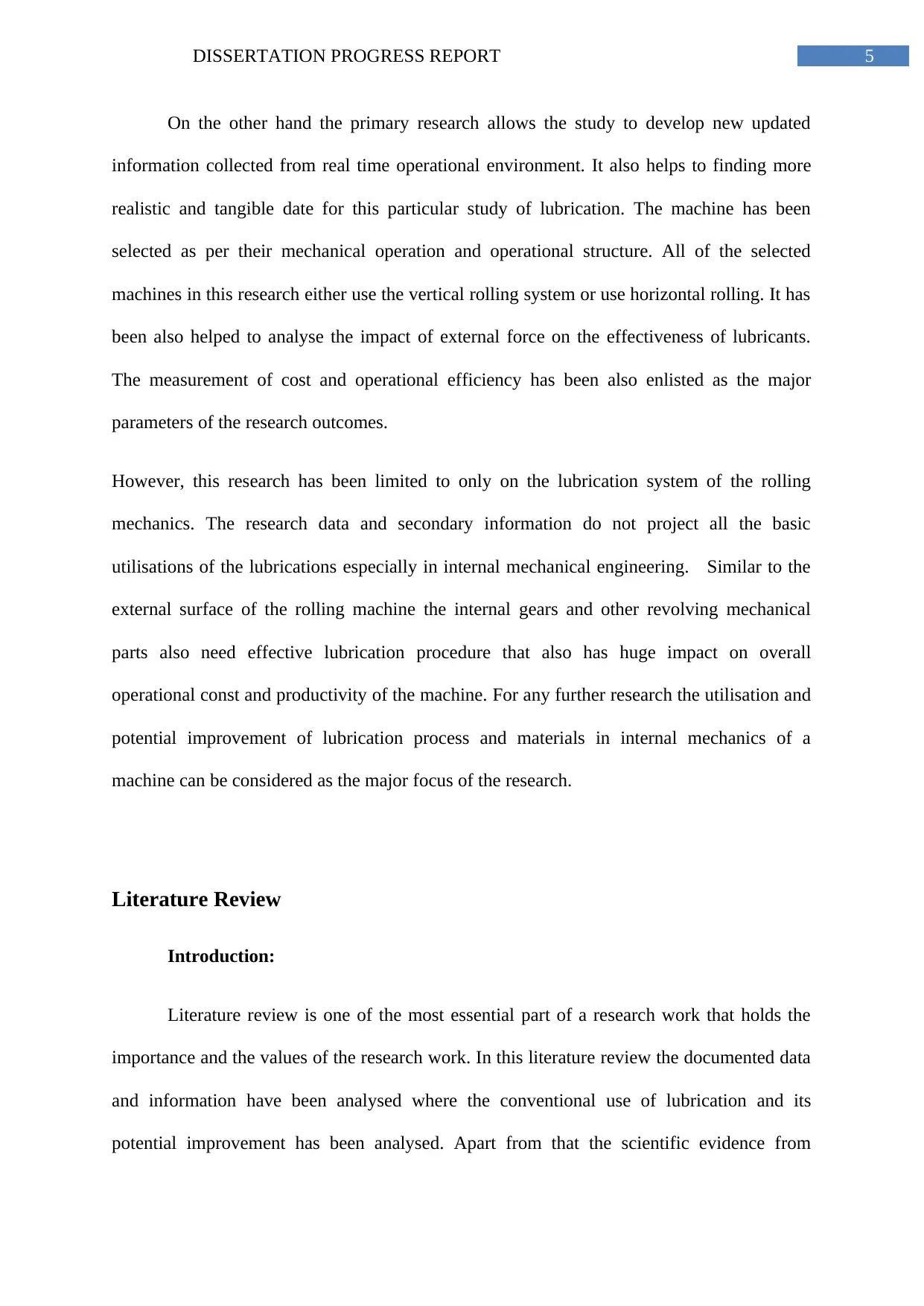
5DISSERTATION PROGRESS REPORT
On the other hand the primary research allows the study to develop new updated
information collected from real time operational environment. It also helps to finding more
realistic and tangible date for this particular study of lubrication. The machine has been
selected as per their mechanical operation and operational structure. All of the selected
machines in this research either use the vertical rolling system or use horizontal rolling. It has
been also helped to analyse the impact of external force on the effectiveness of lubricants.
The measurement of cost and operational efficiency has been also enlisted as the major
parameters of the research outcomes.
However, this research has been limited to only on the lubrication system of the rolling
mechanics. The research data and secondary information do not project all the basic
utilisations of the lubrications especially in internal mechanical engineering. Similar to the
external surface of the rolling machine the internal gears and other revolving mechanical
parts also need effective lubrication procedure that also has huge impact on overall
operational const and productivity of the machine. For any further research the utilisation and
potential improvement of lubrication process and materials in internal mechanics of a
machine can be considered as the major focus of the research.
Literature Review
Introduction:
Literature review is one of the most essential part of a research work that holds the
importance and the values of the research work. In this literature review the documented data
and information have been analysed where the conventional use of lubrication and its
potential improvement has been analysed. Apart from that the scientific evidence from
On the other hand the primary research allows the study to develop new updated
information collected from real time operational environment. It also helps to finding more
realistic and tangible date for this particular study of lubrication. The machine has been
selected as per their mechanical operation and operational structure. All of the selected
machines in this research either use the vertical rolling system or use horizontal rolling. It has
been also helped to analyse the impact of external force on the effectiveness of lubricants.
The measurement of cost and operational efficiency has been also enlisted as the major
parameters of the research outcomes.
However, this research has been limited to only on the lubrication system of the rolling
mechanics. The research data and secondary information do not project all the basic
utilisations of the lubrications especially in internal mechanical engineering. Similar to the
external surface of the rolling machine the internal gears and other revolving mechanical
parts also need effective lubrication procedure that also has huge impact on overall
operational const and productivity of the machine. For any further research the utilisation and
potential improvement of lubrication process and materials in internal mechanics of a
machine can be considered as the major focus of the research.
Literature Review
Introduction:
Literature review is one of the most essential part of a research work that holds the
importance and the values of the research work. In this literature review the documented data
and information have been analysed where the conventional use of lubrication and its
potential improvement has been analysed. Apart from that the scientific evidence from
⊘ This is a preview!⊘
Do you want full access?
Subscribe today to unlock all pages.

Trusted by 1+ million students worldwide
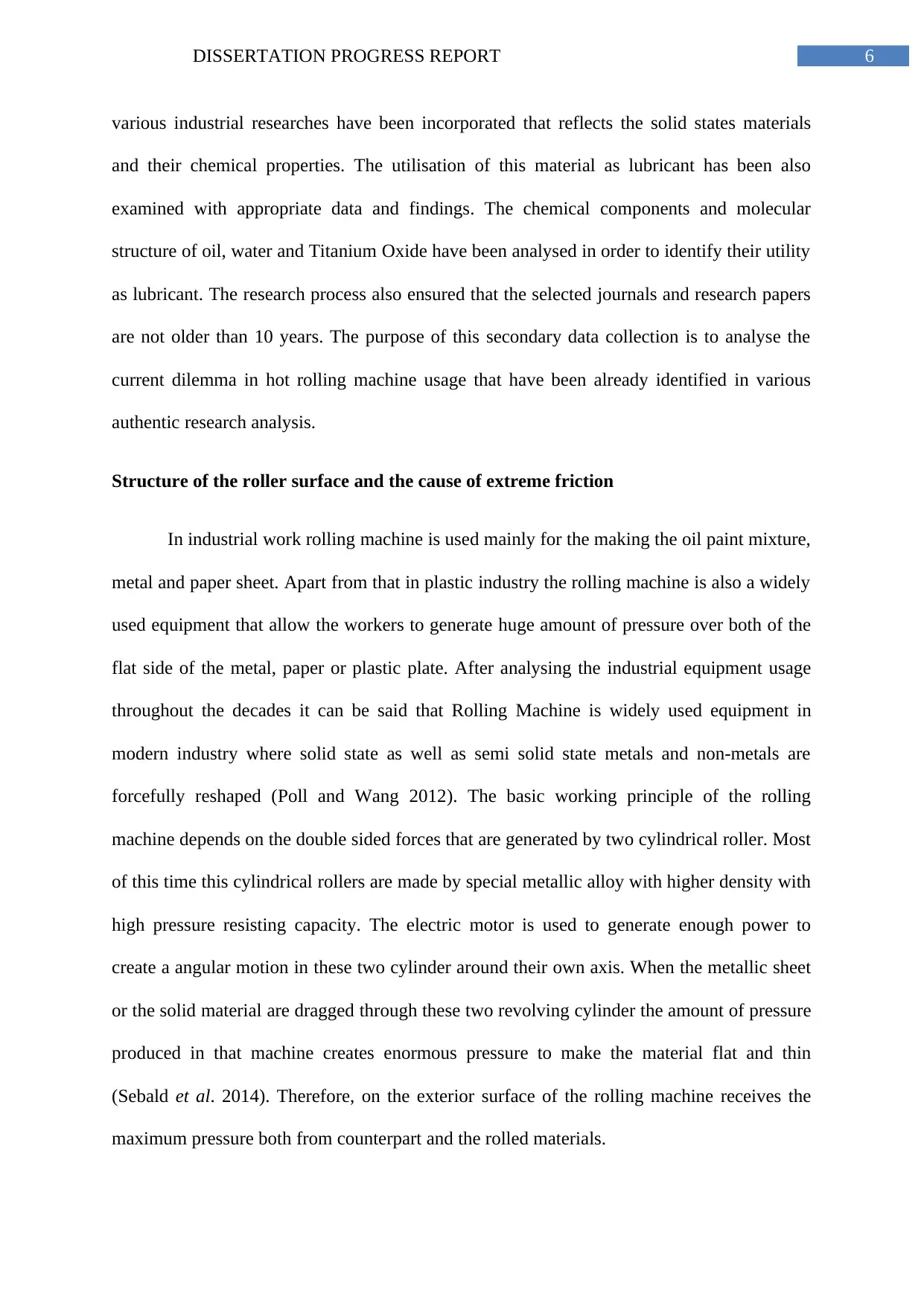
6DISSERTATION PROGRESS REPORT
various industrial researches have been incorporated that reflects the solid states materials
and their chemical properties. The utilisation of this material as lubricant has been also
examined with appropriate data and findings. The chemical components and molecular
structure of oil, water and Titanium Oxide have been analysed in order to identify their utility
as lubricant. The research process also ensured that the selected journals and research papers
are not older than 10 years. The purpose of this secondary data collection is to analyse the
current dilemma in hot rolling machine usage that have been already identified in various
authentic research analysis.
Structure of the roller surface and the cause of extreme friction
In industrial work rolling machine is used mainly for the making the oil paint mixture,
metal and paper sheet. Apart from that in plastic industry the rolling machine is also a widely
used equipment that allow the workers to generate huge amount of pressure over both of the
flat side of the metal, paper or plastic plate. After analysing the industrial equipment usage
throughout the decades it can be said that Rolling Machine is widely used equipment in
modern industry where solid state as well as semi solid state metals and non-metals are
forcefully reshaped (Poll and Wang 2012). The basic working principle of the rolling
machine depends on the double sided forces that are generated by two cylindrical roller. Most
of this time this cylindrical rollers are made by special metallic alloy with higher density with
high pressure resisting capacity. The electric motor is used to generate enough power to
create a angular motion in these two cylinder around their own axis. When the metallic sheet
or the solid material are dragged through these two revolving cylinder the amount of pressure
produced in that machine creates enormous pressure to make the material flat and thin
(Sebald et al. 2014). Therefore, on the exterior surface of the rolling machine receives the
maximum pressure both from counterpart and the rolled materials.
various industrial researches have been incorporated that reflects the solid states materials
and their chemical properties. The utilisation of this material as lubricant has been also
examined with appropriate data and findings. The chemical components and molecular
structure of oil, water and Titanium Oxide have been analysed in order to identify their utility
as lubricant. The research process also ensured that the selected journals and research papers
are not older than 10 years. The purpose of this secondary data collection is to analyse the
current dilemma in hot rolling machine usage that have been already identified in various
authentic research analysis.
Structure of the roller surface and the cause of extreme friction
In industrial work rolling machine is used mainly for the making the oil paint mixture,
metal and paper sheet. Apart from that in plastic industry the rolling machine is also a widely
used equipment that allow the workers to generate huge amount of pressure over both of the
flat side of the metal, paper or plastic plate. After analysing the industrial equipment usage
throughout the decades it can be said that Rolling Machine is widely used equipment in
modern industry where solid state as well as semi solid state metals and non-metals are
forcefully reshaped (Poll and Wang 2012). The basic working principle of the rolling
machine depends on the double sided forces that are generated by two cylindrical roller. Most
of this time this cylindrical rollers are made by special metallic alloy with higher density with
high pressure resisting capacity. The electric motor is used to generate enough power to
create a angular motion in these two cylinder around their own axis. When the metallic sheet
or the solid material are dragged through these two revolving cylinder the amount of pressure
produced in that machine creates enormous pressure to make the material flat and thin
(Sebald et al. 2014). Therefore, on the exterior surface of the rolling machine receives the
maximum pressure both from counterpart and the rolled materials.
Paraphrase This Document
Need a fresh take? Get an instant paraphrase of this document with our AI Paraphraser
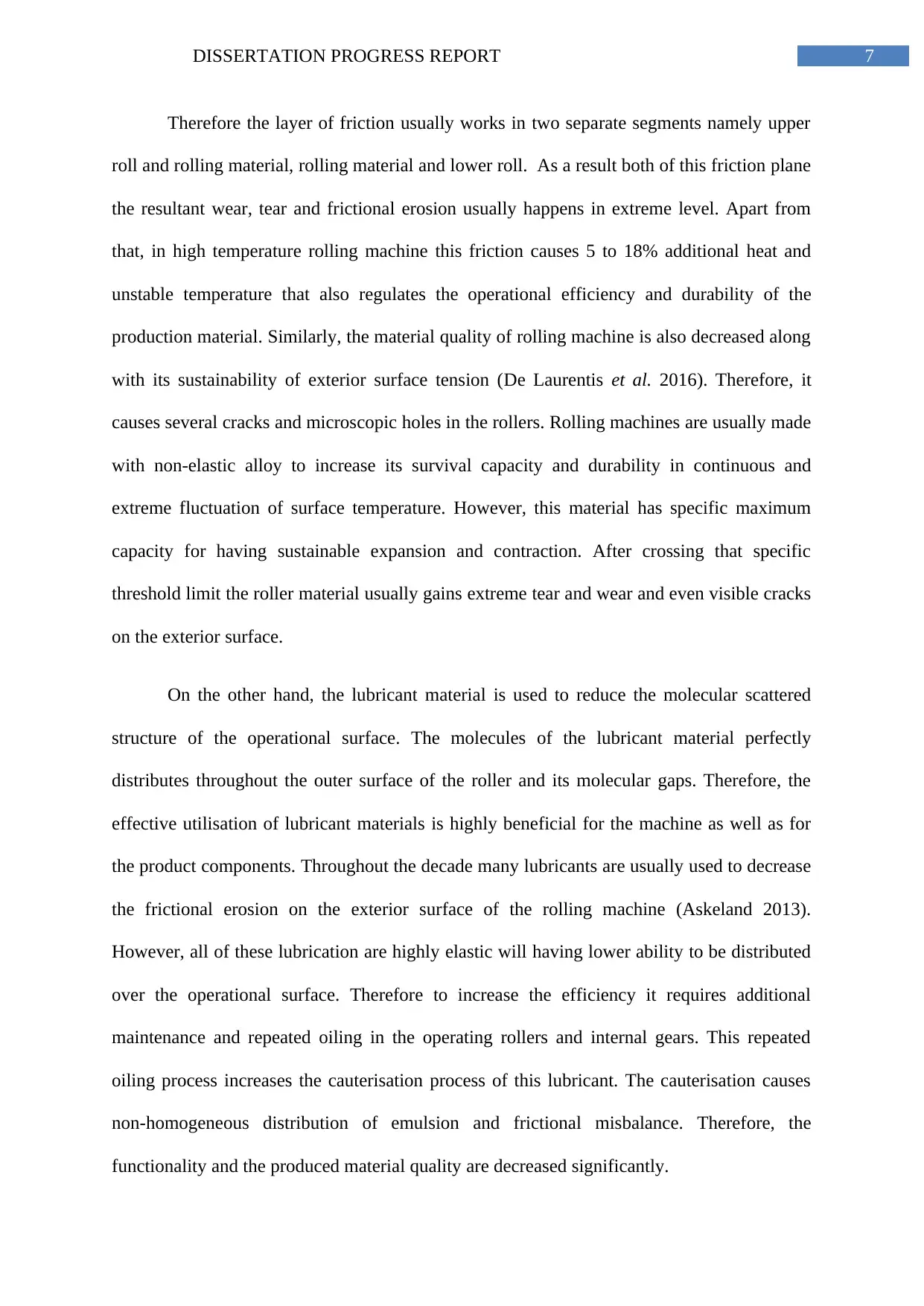
7DISSERTATION PROGRESS REPORT
Therefore the layer of friction usually works in two separate segments namely upper
roll and rolling material, rolling material and lower roll. As a result both of this friction plane
the resultant wear, tear and frictional erosion usually happens in extreme level. Apart from
that, in high temperature rolling machine this friction causes 5 to 18% additional heat and
unstable temperature that also regulates the operational efficiency and durability of the
production material. Similarly, the material quality of rolling machine is also decreased along
with its sustainability of exterior surface tension (De Laurentis et al. 2016). Therefore, it
causes several cracks and microscopic holes in the rollers. Rolling machines are usually made
with non-elastic alloy to increase its survival capacity and durability in continuous and
extreme fluctuation of surface temperature. However, this material has specific maximum
capacity for having sustainable expansion and contraction. After crossing that specific
threshold limit the roller material usually gains extreme tear and wear and even visible cracks
on the exterior surface.
On the other hand, the lubricant material is used to reduce the molecular scattered
structure of the operational surface. The molecules of the lubricant material perfectly
distributes throughout the outer surface of the roller and its molecular gaps. Therefore, the
effective utilisation of lubricant materials is highly beneficial for the machine as well as for
the product components. Throughout the decade many lubricants are usually used to decrease
the frictional erosion on the exterior surface of the rolling machine (Askeland 2013).
However, all of these lubrication are highly elastic will having lower ability to be distributed
over the operational surface. Therefore to increase the efficiency it requires additional
maintenance and repeated oiling in the operating rollers and internal gears. This repeated
oiling process increases the cauterisation process of this lubricant. The cauterisation causes
non-homogeneous distribution of emulsion and frictional misbalance. Therefore, the
functionality and the produced material quality are decreased significantly.
Therefore the layer of friction usually works in two separate segments namely upper
roll and rolling material, rolling material and lower roll. As a result both of this friction plane
the resultant wear, tear and frictional erosion usually happens in extreme level. Apart from
that, in high temperature rolling machine this friction causes 5 to 18% additional heat and
unstable temperature that also regulates the operational efficiency and durability of the
production material. Similarly, the material quality of rolling machine is also decreased along
with its sustainability of exterior surface tension (De Laurentis et al. 2016). Therefore, it
causes several cracks and microscopic holes in the rollers. Rolling machines are usually made
with non-elastic alloy to increase its survival capacity and durability in continuous and
extreme fluctuation of surface temperature. However, this material has specific maximum
capacity for having sustainable expansion and contraction. After crossing that specific
threshold limit the roller material usually gains extreme tear and wear and even visible cracks
on the exterior surface.
On the other hand, the lubricant material is used to reduce the molecular scattered
structure of the operational surface. The molecules of the lubricant material perfectly
distributes throughout the outer surface of the roller and its molecular gaps. Therefore, the
effective utilisation of lubricant materials is highly beneficial for the machine as well as for
the product components. Throughout the decade many lubricants are usually used to decrease
the frictional erosion on the exterior surface of the rolling machine (Askeland 2013).
However, all of these lubrication are highly elastic will having lower ability to be distributed
over the operational surface. Therefore to increase the efficiency it requires additional
maintenance and repeated oiling in the operating rollers and internal gears. This repeated
oiling process increases the cauterisation process of this lubricant. The cauterisation causes
non-homogeneous distribution of emulsion and frictional misbalance. Therefore, the
functionality and the produced material quality are decreased significantly.
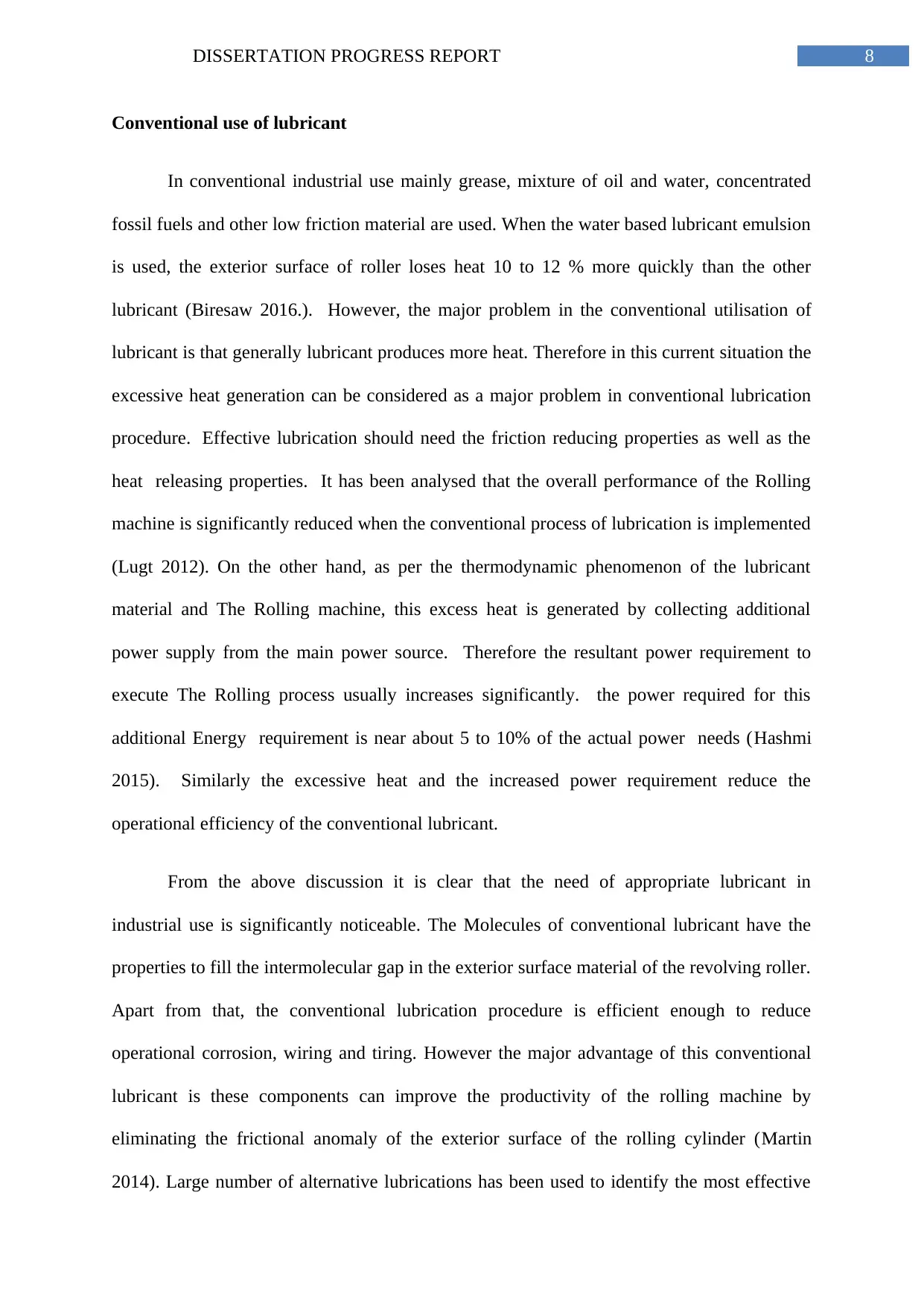
8DISSERTATION PROGRESS REPORT
Conventional use of lubricant
In conventional industrial use mainly grease, mixture of oil and water, concentrated
fossil fuels and other low friction material are used. When the water based lubricant emulsion
is used, the exterior surface of roller loses heat 10 to 12 % more quickly than the other
lubricant (Biresaw 2016.). However, the major problem in the conventional utilisation of
lubricant is that generally lubricant produces more heat. Therefore in this current situation the
excessive heat generation can be considered as a major problem in conventional lubrication
procedure. Effective lubrication should need the friction reducing properties as well as the
heat releasing properties. It has been analysed that the overall performance of the Rolling
machine is significantly reduced when the conventional process of lubrication is implemented
(Lugt 2012). On the other hand, as per the thermodynamic phenomenon of the lubricant
material and The Rolling machine, this excess heat is generated by collecting additional
power supply from the main power source. Therefore the resultant power requirement to
execute The Rolling process usually increases significantly. the power required for this
additional Energy requirement is near about 5 to 10% of the actual power needs (Hashmi
2015). Similarly the excessive heat and the increased power requirement reduce the
operational efficiency of the conventional lubricant.
From the above discussion it is clear that the need of appropriate lubricant in
industrial use is significantly noticeable. The Molecules of conventional lubricant have the
properties to fill the intermolecular gap in the exterior surface material of the revolving roller.
Apart from that, the conventional lubrication procedure is efficient enough to reduce
operational corrosion, wiring and tiring. However the major advantage of this conventional
lubricant is these components can improve the productivity of the rolling machine by
eliminating the frictional anomaly of the exterior surface of the rolling cylinder (Martin
2014). Large number of alternative lubrications has been used to identify the most effective
Conventional use of lubricant
In conventional industrial use mainly grease, mixture of oil and water, concentrated
fossil fuels and other low friction material are used. When the water based lubricant emulsion
is used, the exterior surface of roller loses heat 10 to 12 % more quickly than the other
lubricant (Biresaw 2016.). However, the major problem in the conventional utilisation of
lubricant is that generally lubricant produces more heat. Therefore in this current situation the
excessive heat generation can be considered as a major problem in conventional lubrication
procedure. Effective lubrication should need the friction reducing properties as well as the
heat releasing properties. It has been analysed that the overall performance of the Rolling
machine is significantly reduced when the conventional process of lubrication is implemented
(Lugt 2012). On the other hand, as per the thermodynamic phenomenon of the lubricant
material and The Rolling machine, this excess heat is generated by collecting additional
power supply from the main power source. Therefore the resultant power requirement to
execute The Rolling process usually increases significantly. the power required for this
additional Energy requirement is near about 5 to 10% of the actual power needs (Hashmi
2015). Similarly the excessive heat and the increased power requirement reduce the
operational efficiency of the conventional lubricant.
From the above discussion it is clear that the need of appropriate lubricant in
industrial use is significantly noticeable. The Molecules of conventional lubricant have the
properties to fill the intermolecular gap in the exterior surface material of the revolving roller.
Apart from that, the conventional lubrication procedure is efficient enough to reduce
operational corrosion, wiring and tiring. However the major advantage of this conventional
lubricant is these components can improve the productivity of the rolling machine by
eliminating the frictional anomaly of the exterior surface of the rolling cylinder (Martin
2014). Large number of alternative lubrications has been used to identify the most effective
⊘ This is a preview!⊘
Do you want full access?
Subscribe today to unlock all pages.

Trusted by 1+ million students worldwide
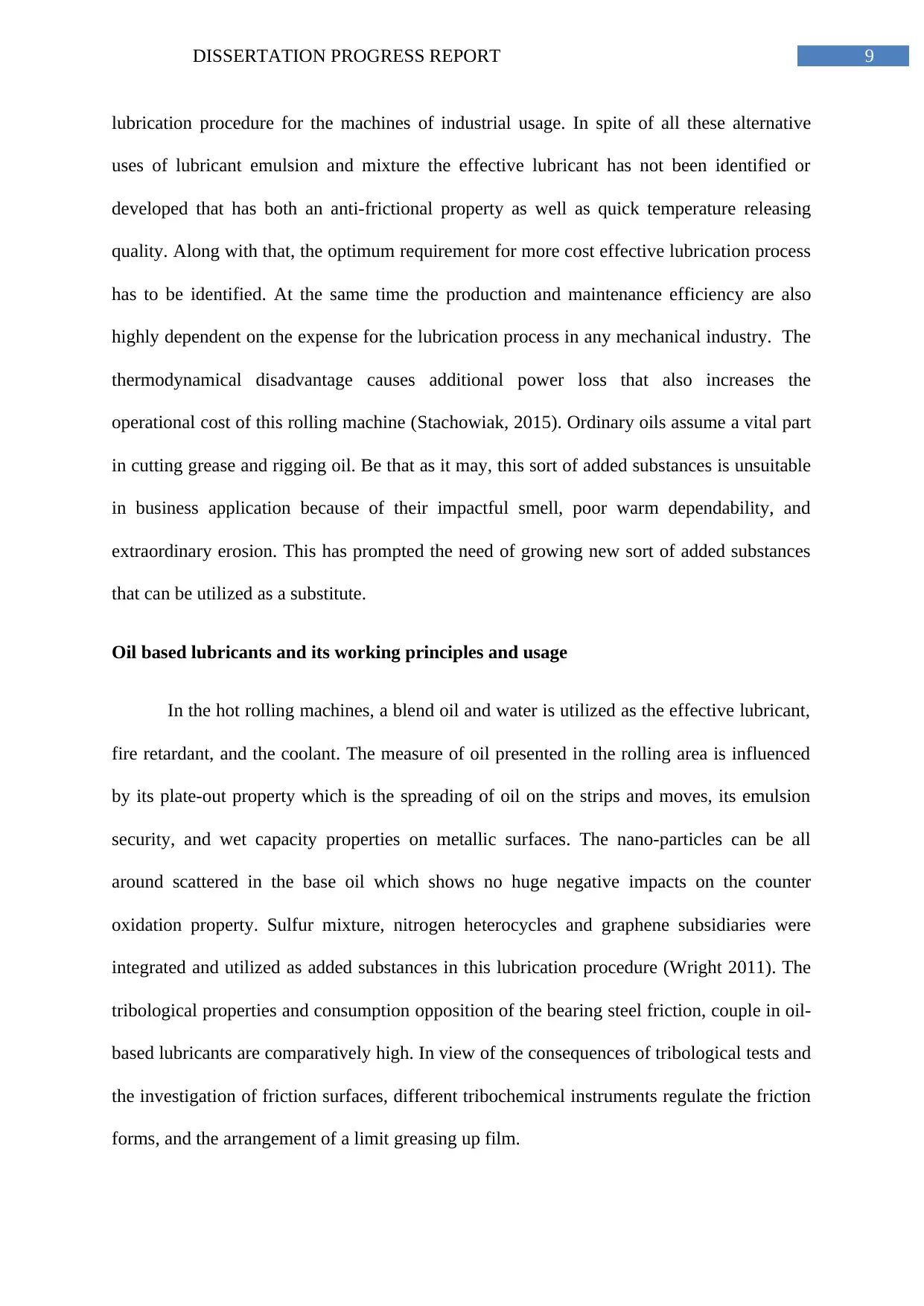
9DISSERTATION PROGRESS REPORT
lubrication procedure for the machines of industrial usage. In spite of all these alternative
uses of lubricant emulsion and mixture the effective lubricant has not been identified or
developed that has both an anti-frictional property as well as quick temperature releasing
quality. Along with that, the optimum requirement for more cost effective lubrication process
has to be identified. At the same time the production and maintenance efficiency are also
highly dependent on the expense for the lubrication process in any mechanical industry. The
thermodynamical disadvantage causes additional power loss that also increases the
operational cost of this rolling machine (Stachowiak, 2015). Ordinary oils assume a vital part
in cutting grease and rigging oil. Be that as it may, this sort of added substances is unsuitable
in business application because of their impactful smell, poor warm dependability, and
extraordinary erosion. This has prompted the need of growing new sort of added substances
that can be utilized as a substitute.
Oil based lubricants and its working principles and usage
In the hot rolling machines, a blend oil and water is utilized as the effective lubricant,
fire retardant, and the coolant. The measure of oil presented in the rolling area is influenced
by its plate-out property which is the spreading of oil on the strips and moves, its emulsion
security, and wet capacity properties on metallic surfaces. The nano-particles can be all
around scattered in the base oil which shows no huge negative impacts on the counter
oxidation property. Sulfur mixture, nitrogen heterocycles and graphene subsidiaries were
integrated and utilized as added substances in this lubrication procedure (Wright 2011). The
tribological properties and consumption opposition of the bearing steel friction, couple in oil-
based lubricants are comparatively high. In view of the consequences of tribological tests and
the investigation of friction surfaces, different tribochemical instruments regulate the friction
forms, and the arrangement of a limit greasing up film.
lubrication procedure for the machines of industrial usage. In spite of all these alternative
uses of lubricant emulsion and mixture the effective lubricant has not been identified or
developed that has both an anti-frictional property as well as quick temperature releasing
quality. Along with that, the optimum requirement for more cost effective lubrication process
has to be identified. At the same time the production and maintenance efficiency are also
highly dependent on the expense for the lubrication process in any mechanical industry. The
thermodynamical disadvantage causes additional power loss that also increases the
operational cost of this rolling machine (Stachowiak, 2015). Ordinary oils assume a vital part
in cutting grease and rigging oil. Be that as it may, this sort of added substances is unsuitable
in business application because of their impactful smell, poor warm dependability, and
extraordinary erosion. This has prompted the need of growing new sort of added substances
that can be utilized as a substitute.
Oil based lubricants and its working principles and usage
In the hot rolling machines, a blend oil and water is utilized as the effective lubricant,
fire retardant, and the coolant. The measure of oil presented in the rolling area is influenced
by its plate-out property which is the spreading of oil on the strips and moves, its emulsion
security, and wet capacity properties on metallic surfaces. The nano-particles can be all
around scattered in the base oil which shows no huge negative impacts on the counter
oxidation property. Sulfur mixture, nitrogen heterocycles and graphene subsidiaries were
integrated and utilized as added substances in this lubrication procedure (Wright 2011). The
tribological properties and consumption opposition of the bearing steel friction, couple in oil-
based lubricants are comparatively high. In view of the consequences of tribological tests and
the investigation of friction surfaces, different tribochemical instruments regulate the friction
forms, and the arrangement of a limit greasing up film.
Paraphrase This Document
Need a fresh take? Get an instant paraphrase of this document with our AI Paraphraser
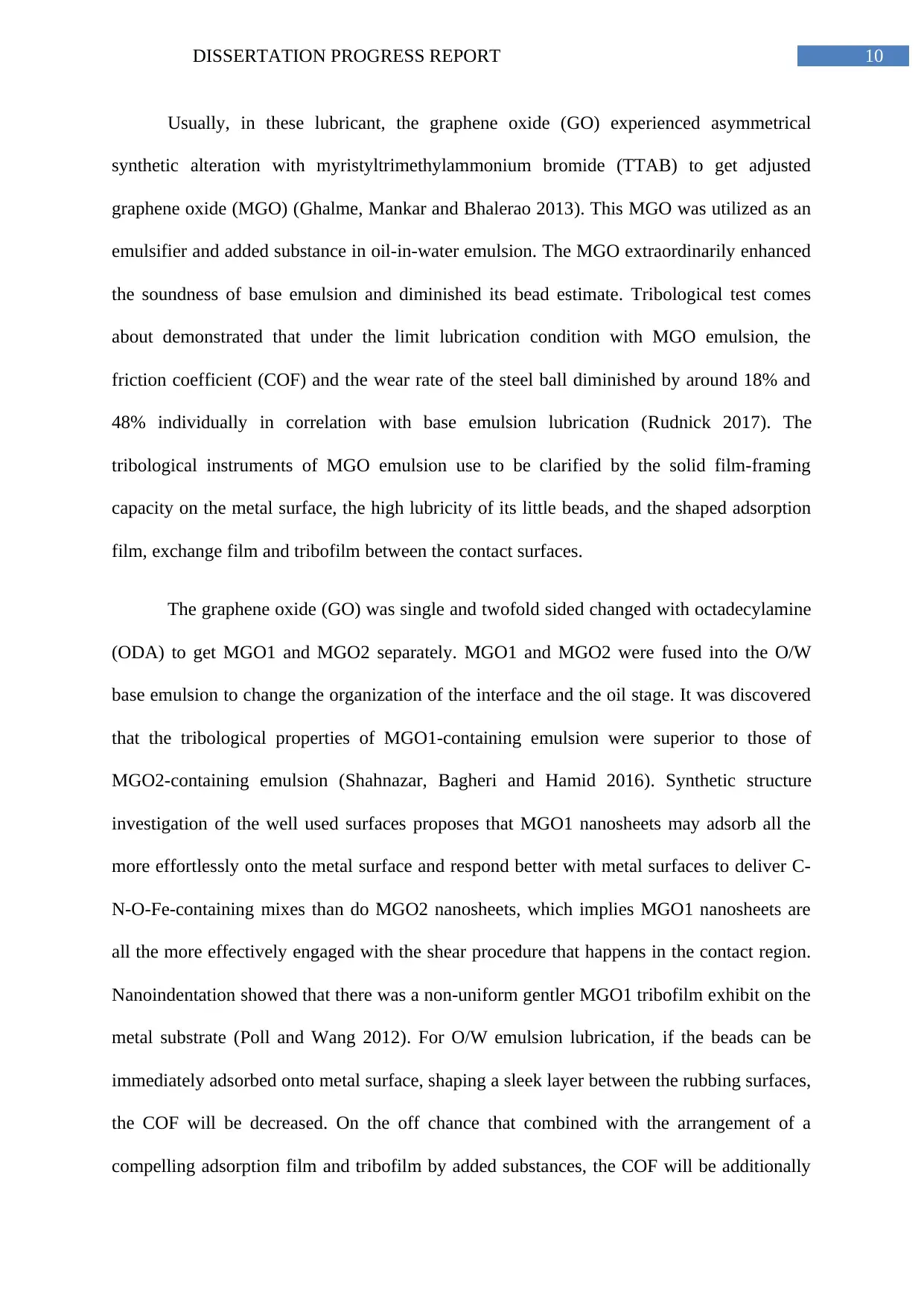
10DISSERTATION PROGRESS REPORT
Usually, in these lubricant, the graphene oxide (GO) experienced asymmetrical
synthetic alteration with myristyltrimethylammonium bromide (TTAB) to get adjusted
graphene oxide (MGO) (Ghalme, Mankar and Bhalerao 2013). This MGO was utilized as an
emulsifier and added substance in oil-in-water emulsion. The MGO extraordinarily enhanced
the soundness of base emulsion and diminished its bead estimate. Tribological test comes
about demonstrated that under the limit lubrication condition with MGO emulsion, the
friction coefficient (COF) and the wear rate of the steel ball diminished by around 18% and
48% individually in correlation with base emulsion lubrication (Rudnick 2017). The
tribological instruments of MGO emulsion use to be clarified by the solid film-framing
capacity on the metal surface, the high lubricity of its little beads, and the shaped adsorption
film, exchange film and tribofilm between the contact surfaces.
The graphene oxide (GO) was single and twofold sided changed with octadecylamine
(ODA) to get MGO1 and MGO2 separately. MGO1 and MGO2 were fused into the O/W
base emulsion to change the organization of the interface and the oil stage. It was discovered
that the tribological properties of MGO1-containing emulsion were superior to those of
MGO2-containing emulsion (Shahnazar, Bagheri and Hamid 2016). Synthetic structure
investigation of the well used surfaces proposes that MGO1 nanosheets may adsorb all the
more effortlessly onto the metal surface and respond better with metal surfaces to deliver C-
N-O-Fe-containing mixes than do MGO2 nanosheets, which implies MGO1 nanosheets are
all the more effectively engaged with the shear procedure that happens in the contact region.
Nanoindentation showed that there was a non-uniform gentler MGO1 tribofilm exhibit on the
metal substrate (Poll and Wang 2012). For O/W emulsion lubrication, if the beads can be
immediately adsorbed onto metal surface, shaping a sleek layer between the rubbing surfaces,
the COF will be decreased. On the off chance that combined with the arrangement of a
compelling adsorption film and tribofilm by added substances, the COF will be additionally
Usually, in these lubricant, the graphene oxide (GO) experienced asymmetrical
synthetic alteration with myristyltrimethylammonium bromide (TTAB) to get adjusted
graphene oxide (MGO) (Ghalme, Mankar and Bhalerao 2013). This MGO was utilized as an
emulsifier and added substance in oil-in-water emulsion. The MGO extraordinarily enhanced
the soundness of base emulsion and diminished its bead estimate. Tribological test comes
about demonstrated that under the limit lubrication condition with MGO emulsion, the
friction coefficient (COF) and the wear rate of the steel ball diminished by around 18% and
48% individually in correlation with base emulsion lubrication (Rudnick 2017). The
tribological instruments of MGO emulsion use to be clarified by the solid film-framing
capacity on the metal surface, the high lubricity of its little beads, and the shaped adsorption
film, exchange film and tribofilm between the contact surfaces.
The graphene oxide (GO) was single and twofold sided changed with octadecylamine
(ODA) to get MGO1 and MGO2 separately. MGO1 and MGO2 were fused into the O/W
base emulsion to change the organization of the interface and the oil stage. It was discovered
that the tribological properties of MGO1-containing emulsion were superior to those of
MGO2-containing emulsion (Shahnazar, Bagheri and Hamid 2016). Synthetic structure
investigation of the well used surfaces proposes that MGO1 nanosheets may adsorb all the
more effortlessly onto the metal surface and respond better with metal surfaces to deliver C-
N-O-Fe-containing mixes than do MGO2 nanosheets, which implies MGO1 nanosheets are
all the more effectively engaged with the shear procedure that happens in the contact region.
Nanoindentation showed that there was a non-uniform gentler MGO1 tribofilm exhibit on the
metal substrate (Poll and Wang 2012). For O/W emulsion lubrication, if the beads can be
immediately adsorbed onto metal surface, shaping a sleek layer between the rubbing surfaces,
the COF will be decreased. On the off chance that combined with the arrangement of a
compelling adsorption film and tribofilm by added substances, the COF will be additionally
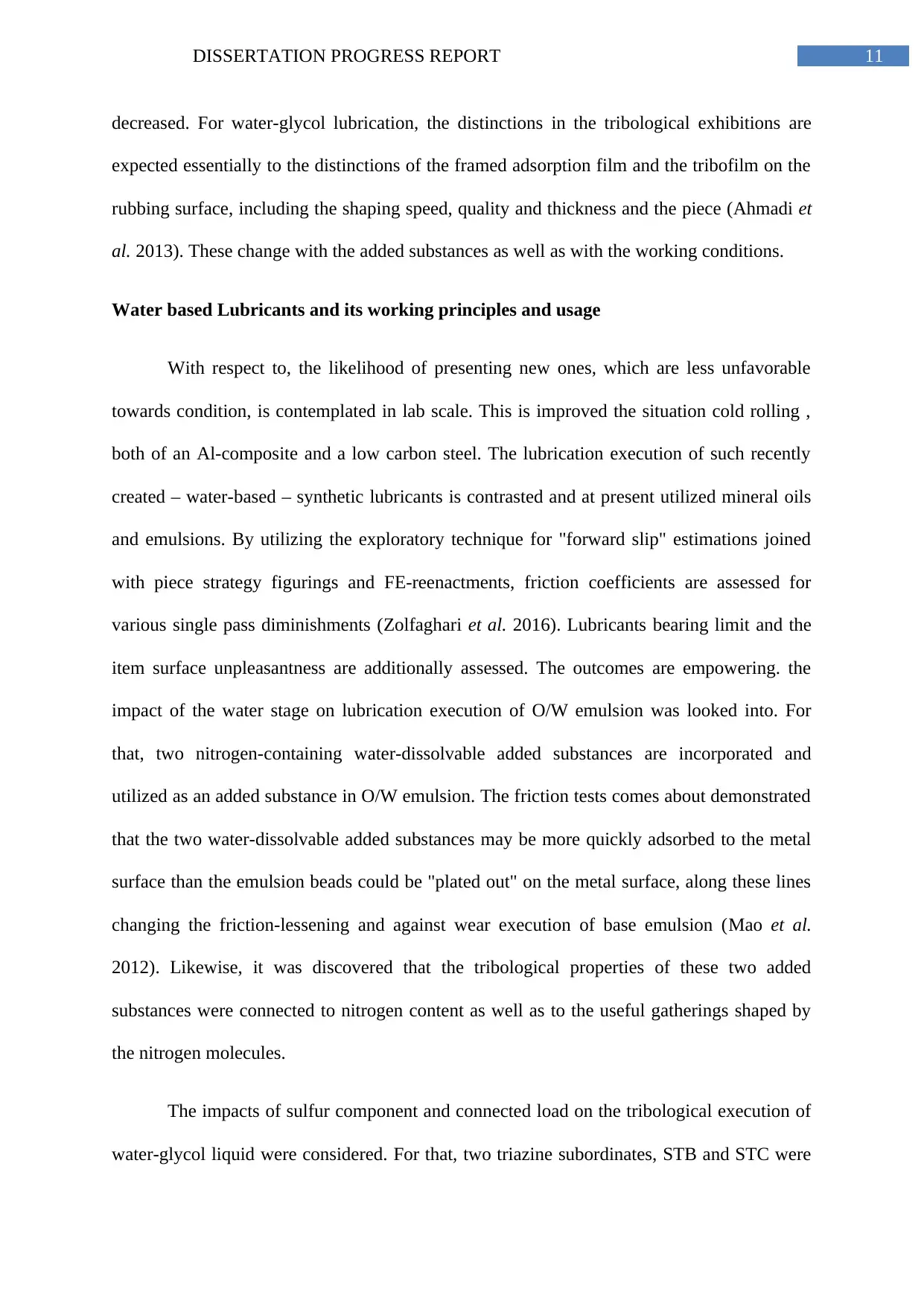
11DISSERTATION PROGRESS REPORT
decreased. For water-glycol lubrication, the distinctions in the tribological exhibitions are
expected essentially to the distinctions of the framed adsorption film and the tribofilm on the
rubbing surface, including the shaping speed, quality and thickness and the piece (Ahmadi et
al. 2013). These change with the added substances as well as with the working conditions.
Water based Lubricants and its working principles and usage
With respect to, the likelihood of presenting new ones, which are less unfavorable
towards condition, is contemplated in lab scale. This is improved the situation cold rolling ,
both of an Al-composite and a low carbon steel. The lubrication execution of such recently
created – water-based – synthetic lubricants is contrasted and at present utilized mineral oils
and emulsions. By utilizing the exploratory technique for "forward slip" estimations joined
with piece strategy figurings and FE-reenactments, friction coefficients are assessed for
various single pass diminishments (Zolfaghari et al. 2016). Lubricants bearing limit and the
item surface unpleasantness are additionally assessed. The outcomes are empowering. the
impact of the water stage on lubrication execution of O/W emulsion was looked into. For
that, two nitrogen-containing water-dissolvable added substances are incorporated and
utilized as an added substance in O/W emulsion. The friction tests comes about demonstrated
that the two water-dissolvable added substances may be more quickly adsorbed to the metal
surface than the emulsion beads could be "plated out" on the metal surface, along these lines
changing the friction-lessening and against wear execution of base emulsion (Mao et al.
2012). Likewise, it was discovered that the tribological properties of these two added
substances were connected to nitrogen content as well as to the useful gatherings shaped by
the nitrogen molecules.
The impacts of sulfur component and connected load on the tribological execution of
water-glycol liquid were considered. For that, two triazine subordinates, STB and STC were
decreased. For water-glycol lubrication, the distinctions in the tribological exhibitions are
expected essentially to the distinctions of the framed adsorption film and the tribofilm on the
rubbing surface, including the shaping speed, quality and thickness and the piece (Ahmadi et
al. 2013). These change with the added substances as well as with the working conditions.
Water based Lubricants and its working principles and usage
With respect to, the likelihood of presenting new ones, which are less unfavorable
towards condition, is contemplated in lab scale. This is improved the situation cold rolling ,
both of an Al-composite and a low carbon steel. The lubrication execution of such recently
created – water-based – synthetic lubricants is contrasted and at present utilized mineral oils
and emulsions. By utilizing the exploratory technique for "forward slip" estimations joined
with piece strategy figurings and FE-reenactments, friction coefficients are assessed for
various single pass diminishments (Zolfaghari et al. 2016). Lubricants bearing limit and the
item surface unpleasantness are additionally assessed. The outcomes are empowering. the
impact of the water stage on lubrication execution of O/W emulsion was looked into. For
that, two nitrogen-containing water-dissolvable added substances are incorporated and
utilized as an added substance in O/W emulsion. The friction tests comes about demonstrated
that the two water-dissolvable added substances may be more quickly adsorbed to the metal
surface than the emulsion beads could be "plated out" on the metal surface, along these lines
changing the friction-lessening and against wear execution of base emulsion (Mao et al.
2012). Likewise, it was discovered that the tribological properties of these two added
substances were connected to nitrogen content as well as to the useful gatherings shaped by
the nitrogen molecules.
The impacts of sulfur component and connected load on the tribological execution of
water-glycol liquid were considered. For that, two triazine subordinates, STB and STC were
⊘ This is a preview!⊘
Do you want full access?
Subscribe today to unlock all pages.

Trusted by 1+ million students worldwide
1 out of 32
Your All-in-One AI-Powered Toolkit for Academic Success.
+13062052269
info@desklib.com
Available 24*7 on WhatsApp / Email
![[object Object]](/_next/static/media/star-bottom.7253800d.svg)
Unlock your academic potential
Copyright © 2020–2025 A2Z Services. All Rights Reserved. Developed and managed by ZUCOL.
